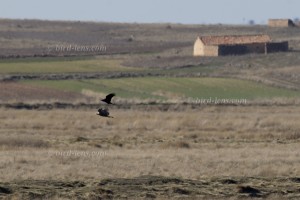Going for Laguna de Gallocanta, this lake on 1,000 m asl in the middle of Northern Spain, seems to be good for impressive numbers of wintering birds as well as  for surprises. Some years ago, there has been observations of a Sandhill Crane (Grus canadensis). Actually, I wanted to watch and photograph Common Cranes (Grus grus) on their resting and wintering grounds. These birds breed in Germany, Fennoscandia and the Baltic States, and then take a western migration route through Europe to wintering areas. It is estimated that the total number of birds that migrate along the western route count up to 70,000 individuals. Most of them 50,000-60,000 wintering in Spain. The rest of the population in Portugal and Morocco. A special highlight is that some 70,000 individuals in October can be seen on the way from their breeding grounds and on return migration in February / March. In the winter period, significantly fewer individuals are to be found at the lagoon. The number of wintering birds probably also depends upon the farmers growing.
for surprises. Some years ago, there has been observations of a Sandhill Crane (Grus canadensis). Actually, I wanted to watch and photograph Common Cranes (Grus grus) on their resting and wintering grounds. These birds breed in Germany, Fennoscandia and the Baltic States, and then take a western migration route through Europe to wintering areas. It is estimated that the total number of birds that migrate along the western route count up to 70,000 individuals. Most of them 50,000-60,000 wintering in Spain. The rest of the population in Portugal and Morocco. A special highlight is that some 70,000 individuals in October can be seen on the way from their breeding grounds and on return migration in February / March. In the winter period, significantly fewer individuals are to be found at the lagoon. The number of wintering birds probably also depends upon the farmers growing.
I planned a short trip in early March. With great sunny weather and – despite the altitude – in pleasant temperatures I left my accommodation in the village of Gallocanta to head for westerly shore of the Laguna de Gallocanta. The whole area has the status of a Refugio de Fauna Silvestre and is also a Ramsar site. With 6,720 acres, it is quite generously sized. Supposedly, it is the largest natural lake in Spain. The water surface of Laguna Gallocanta amounts to 1,500 ha.
One special feature is that the lake is largely fed by rain water, which causes some dramatic water level fluctuations. During hot summer the lake might dry out. But now in early spring there is enough water albeit some mud around the shoreline which is good for waders as Ruff (Calidris pugnax). It’s 1 pm already when I start for the second excursion of the day. The sun is high. When I came to the observation tower, the Observatorio de La Reguera, are only a few observers are present on the steel tower. One birder with a keen eye and a spotting scope gave me the hint on a great eagle on lakeside. Hey, that’s a Golden Eagle (Aquila chrysaetos) – nearly an adult bird. The eagle actually rested on the lakeshore and was closely monitored by 2 Common Ravens (Corvus corax). Certainly an unusual experience. Shortly after the golden eagle was eventually disturbed by corvids that he took off for a flight. During departure the eagle was still harassed for a while. During flight, the bright white windows in the primaries on the underwings could be seen very well, showing that the eagle was still not fully grown. The tail, however, already showed no white on the base. Finally, a Red Kite (Milvus milvus) passed by to have a look on the eagle, too. Finally the eagle was gone behind a hill and remained disappeared.
The whole of the laguna is very interesting especially in winter and early spring time. In addition to the Common Cranes, wintering (and sometimes breeding) birds include a few Great Bustards (Otis tarda), Stone Curlew (Burhinus oedicnemus), Merlin (Falco columbarius), Shelduck (Tadorna Tadorna), Shoveler (Anas clypeata), Marsh Harrier (Circus aeruginosus), Northern Harriers (Circus cyaneus), Water Rail (Rallus aquaticus), Northern Lapwings (Vanellus vanellus), Water Pipit (Anthus spinoletta) and other interesting species. In particular, a few interesting lark species are at home here.
The lake is at least 1,000 m above sea level. Winter temperatures can therefore be crisp cold. With a warm sun from a bright blue sky temperatures are pleasant. The surrounding fields have steppe character, although a big part is now being intensively used for agriculture. The lake, the Laguna de Gallocanta, is located inland in the middle of Aragon. The Laguna is the wintering home for over 10,000 Common Cranes that flee from the cold winter in Central Europe. It is an impressive natural spectacle when the birds start from their resting area in the shallow water of the lake and fly to surrounding fields for feeding.
Who wants to drive in the northern Spain, must undertake a long journey by car on from Central Europe. The nearest airport is in Zaragoza indeed; approximately in the middle of the Aragon region. The airport of Zaragoza used to be served by RyanAir a while, too. Now, however, it seems that one must fly for Barcelona instead. This is an additional distance of roughly 250km.
To cope with the growing demand for top shots of the rarer species of the palearctic Bird-Lens is keen to enrich the range of pictures of birds you can find in the western Palearctic. Trips to remote places like Finland in wintertime or to Spain in spring to capture images of rare birds of the western Palearctic were very successful. The nice image you find in that blog is only an appetizer, what you will find in the gallery in the “Pictures Shop”. Just give me a message, if I could serve you with an additional image.